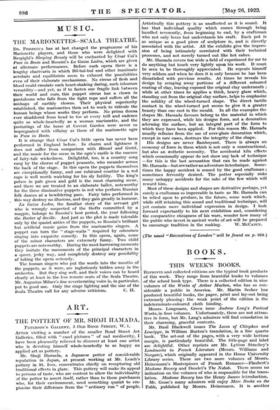ART.
THE POTTERY OF MR. SHOJI HAMADA.
PATERSON'S GALLERY, 5 OLD BOND STREET, W. 1.
AFTER visiting a number of the smaller Bond Street Art Galleries, filled with " easel pictures " of sad mediocrity, I have been pleasantly relieved to discover at least one artist who is devoting himself whole-heartedly to so happy an applied art as pottery.
Mr. Shoji Hamada, a Japanese potter of considerable reputation in Japan, at present working at Mr. Leach's pottery in St. Ives, concentrates chiefly on recapturing old traditional effects in glaze. This pottery will make its appeal to persons of taste, who are content to allow the individuality of the potter to assert itself, rather than to those purchasers who, for their environment, need something quaint to em- phasize their difference from the " ordinary run " of people.
Artistically this pottery is as unaffected as it is sound. It has that individual quality which comes through being handled reverently, from beginning to end, by a craftsman who not only loves but understands his craft. Each pot is as unique as a good piece of sculpture is, and is directly associated with the artist. All the exhibits give the impres- sion of being intimately correlated with their technical processes, and not merely turned out like hot cakes.
Mr. Hamada covers too wide a field of experiment for me to do anything but touch very lightly upon his work. It must be seen to be thoroughly appreciated. He repeats himself very seldom and when he does it is only because he has been dissatisfied with previous results. At times he reveals his design by scraping away portions of a different coloured coating of clay, leaving exposed the original clay underneath ; while at other times he applies a thick, heavy glaze which, standing out from the original clay surface, helps to emphasize the solidity of the wheel-turned shape. The direct tactile contact in the wheel-turned pot seems to give it a greater beauty than one cast in the mould. In all the examples the
shapes Mr. Hamada favours belong to the material in which they are expressed, while his designs form, not a decoration
adorning the surface, but an integral part of the form to which they have been applied. For this reason Mr. Hamada usually refrains from the use of over-glaze decoration which, except in rare cases, destroys the integrity of the shape.
His designs are never flamboyant. There is always an economy of force in them which is not only a constructional, but also an (esthetic necessity. The accidental kiln effects which occasionally appear do not show any lack of technique —for this is the last accusation that can be made against Mr. Hamada—but arerather an adventure in technique. Some- times the happy accident is sensed by the good craftsman ; sometimes fervently desired. The potter especially risks many unhappy accidents for the sake of the few which will reward him.
Most of these designs and shapes are derivative perhaps, yet surely a craftsman so impeccable in taste as Mr. Hamada can be relied upon to produce, in the future, some work which, while still retaining this sound and traditional technique, will yet contain more individual expression in design. I look forward expectantly to his next exhibition and, considering the comparative cheapness of his ware, wonder how many of the public who invest in ancient works of art will be prepared to encourage tradition in the making. W. MCCANCE.










































 Previous page
Previous page